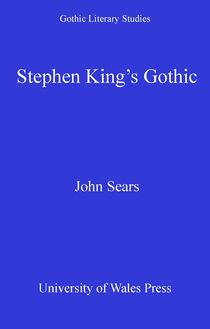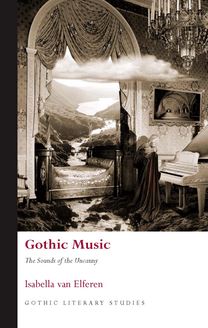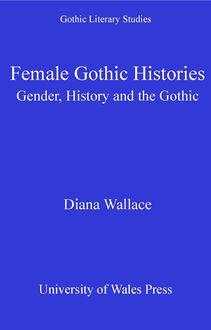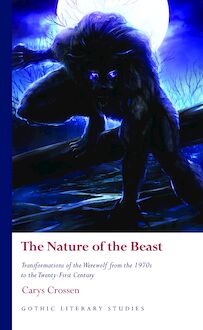-
 Univers
Univers
-
 Ebooks
Ebooks
-
 Livres audio
Livres audio
-
 Presse
Presse
-
 Podcasts
Podcasts
-
 BD
BD
-
 Documents
Documents
-
- Cours
- Révisions
- Ressources pédagogiques
- Sciences de l’éducation
- Manuels scolaires
- Langues
- Travaux de classe
- Annales de BEP
- Etudes supérieures
- Maternelle et primaire
- Fiches de lecture
- Orientation scolaire
- Méthodologie
- Corrigés de devoir
- Annales d’examens et concours
- Annales du bac
- Annales du brevet
- Rapports de stage
La lecture à portée de main
Découvre YouScribe en t'inscrivant gratuitement
Je m'inscrisDécouvre YouScribe en t'inscrivant gratuitement
Je m'inscrisEn savoir plus
En savoir plus

Description
The term ‘Gothic’ has rarely been brought to bear on contemporary South African fictions, appearing too fanciful for the often overtly political writing of apartheid and post-apartheid South Africa. As the first book-length exploration of Gothic impulses in South African literature, this volume accounts for the Gothic currents that run through South African imaginaries from the late-nineteenth century onwards. South African Gothic identifies an intensification in Gothic production that begins with the nascent decline of the apartheid state, and relates this to real anxieties that arise with the unfolding of social and political change. In the context of a South Africa unmaking and reshaping itself, Gothic emerges as a language for long-suppressed histories of violence, and for ongoing experiences at odds with utopian images of the new democracy. Its function is interrogative and ultimately creative: South African Gothic challenges narrow conceptions of the status quo to drive at alternative, less exclusionary visions.
Acknowledgements
Chapter 1
Introduction: South African Gothic, Heterotopia and Dissent
Chapter 2
The Pastoral Unconscious: Gothic and Interregnum in Late-Apartheid Fiction
Chapter 3
Writing Phantoms: Gothic Mourning in the Time of Transition
Chapter 4
Liberation/Neoliberalism: South African Horror after the Millennium
Chapter 5
Coda: Towards Creative Dissent
Notes
Works Cited
Sujets
Informations
| Publié par | University of Wales Press |
| Date de parution | 15 juin 2018 |
| Nombre de lectures | 0 |
| EAN13 | 9781786832474 |
| Langue | English |
| Poids de l'ouvrage | 1 Mo |
Informations légales : prix de location à la page 0,3450€. Cette information est donnée uniquement à titre indicatif conformément à la législation en vigueur.
Extrait
SOUTH AFRICAN GOTHICSERIES PREFACE
Gothic Literary Studies is dedicated to publishing groundbreaking
scholarship on Gothic in literature and flm. The Gothic, which has
been subjected to a variety of critical and theoretical approaches,
is a form which plays an important role in our understanding of
literary, intellectual and cultural histories. The series seeks to promote
challenging and innovative approaches to Gothic which question
any aspect of the Gothic tradition or perceived critical orthodoxy.
Volumes in the series explore how issues such as gender, religion,
nation and sexuality have shaped our view of the Gothic tradition.
Both academically rigorous and informed by the latest developments
in critical theory, the series provides an important focus for scholarly
developments in Gothic studies, literary studies, cultural studies and
critical theory. The series will be of interest to students of all levels
and to scholars and teachers of the Gothic and literary and cultural
histories.
SERIES EDITORS
Andrew Smith, University of Sheffeld
Benjamin F. Fisher, University of Mississippi
EDITORIAL BOARD
Kent Ljungquist, Worcester Polytechnic Institute Massachusetts
Richard Fusco, St Joseph’s University, Philadelphia
David Punter, University of Bristol
Chris Baldick, University of London
Angela Wright, University of Sheffeld
Jerrold E. Hogle, University of Arizona
For all titles in the Gothic Literary Studies series
visit www.uwp.co.ukSouth African Gothic
Anxiety and Creative Dissent in the
Post-apartheid Imagination and Beyond
by
Rebecca Duncan
UNIVERSITY OF WALES PRESS
2018© Rebecca Duncan, 2018
All rights reserved. No part of this book may be reproduced in any material
form (including photocopying or storing it in any medium by electronic
means and whether or not transiently or incidentally to some other use of
this publication) without the written permission of the copyright owner.
Applications for the copyright owner’s written permission to reproduce
any part of this publication should be addressed to the University of Wales
Press, 10 Columbus Walk, Brigantine Place, Cardiff CF10 4UP.
www.uwp.co.uk
British Library Cataloguing-in-Publication Data
A catalogue record for this book is available from the British Library.
ISBN 978-1-78683-246-7
e-ISBN 978-1-78683-247-4
The right of Rebecca Duncan to be identifed as author of this work has
been asserted by her in accordance with sections 77 and 79 of the
Copyright, Designs and Patents Act 1988.
Zugl.: Giessen, Univ., (FB 05), Diss., 2015
Typeset in Wales by Eira Fenn Gaunt, Pentyrch, Cardiff
Printed by CPI Antony Rowe, MelkshamFor FinnThis page intentionally left blank Contents
Acknowledgements ix
1 Introduction: South African Gothic, Heterotopia
and Dissent1
2 The Pastoral Unconscious: Gothic and Interregnum
in Late Apartheid Fiction 43
3 Writing Phantoms: Gothic Mourning in the Time
of Transition 89
4 Liberation/Neoliberalism: South African Horror
after the Millennium 137
5 Coda: Towards Creative Dissent 179
Notes 195
Works Cited 239
Index257This page intentionally left blank ACknowledgements
This book is the product of many things. Its distant roots lie, in the
frst instance, in the English department at the University of Cape
Town, which brought me into contact with both gothic and South
African writing across my undergraduate and MA careers. Since
then, South African Gothic has taken me from South Africa to Germany
and to Scotland. It has entailed the challenges and rewards of learning
a new language, and of multiple relocations. As a result, the valency
of this book is – as is doubtless always the case – much wider and
weightier than the mass of its collected pages. That it is also my
doctoral research makes it all the more signifcant to me. For the
studentship that has enabled me to bring this project to fruition I
gratefully acknowledge the Deutscher Akademischer Austauschdienst.
To my doctoral supervisors Professor Ulrich Horstmann and
Professor Dale Townshend, I extend my profound thanks: for their
unfailing guidance, their support and their enthusiasm. I also
acknowledge, with appreciation, the support for this project provided
by the International Graduate Centre for the Study of Culture and
by the International PhD Programme (IPP), both at Giessen University.
For their responsiveness and their constructive criticism, I thank,
in particular, all the participants of the IPP colloquia for Jahrgang
X. Special thanks are extended, too, to Dr Christina Schwanecke,
without whom navigating the administrative labyrinth of a new
institution would have been a far less painless experience.
To Rebekah Cumpsty, for reading unreasonably vast swathes of
this book and for countless conversations, I am deeply and especially
grateful. Esthie Hugo and Lobke Minter have also provided welcome
extra pairs of eyes during this writing process, and I thank them
both for their careful reading. For illuminating conversations that Acknowledgements
took place during the early stages of this project, my thanks to David
Attwell, and to Meg Samuelson. To Matt Foley, for his advice – and
for the conviction with which he is able to deliver the phrase ‘It’ll
be fne’ – I am grateful too. And also to many others: Shannon
Rollins, Laura Rose, Katharina Zilles, Liam Langan, Carolin Lubos,
Glenn Moncrieff, Jen Burton, Neil McRobert, Tobias Gabel,
Alexander Eilers, Elizabeth Kovach, Matt Forrest. All deserve
particular mention.
I would also like to thank Sarah Lewis, commissioning editor at
University Wales of Press, for guiding me assuredly through my
frst foray into monograph publishing, and also Andrew Smith,
co-editor of UWP’s Gothic Literary Studies series.
For his patience, his painstaking proofreading, and his ceaseless
support, my deepest thanks to Finn Daniels-Yeomans.
And fnally, to my family, and to Lesley and Gordon Duncan
especially: thank you.
The publisher gratefully acknowledges permission granted to reproduce
extracts from the following works:
The Conservationist by Nadine Gordimer, copyright © 1972, 1973,
1974 Nadine Gordimer; by permission of Viking Books, an imprint
of Penguin Publishing Group, a division of Penguin Random House
LLC, all rights reserved
The Conservationist by Nadine Gordimer, published by Jonathan
Cape; reproduced by permission of The Random House Group
Ltd © 1974
In the Heart of the Country: A Novel by J.M. Coetzee, copyright
© 1976, 1977 J. M. Coetzee; by permission of Penguin Books, an
imprint of Penguin Publishing Group, a division of Penguin Random
House LLC, all rights reserved
In the Heart Of the Country by J. M. Coetzee, published by Secker;
reproduced by permission of The Random House Group Ltd ©
1987
David’s Story by Zoë Wicomb, copyright © 2000 by Zoë Wicomb;
reproduced by permission of The Permissions Company Inc., on
behalf of The Feminist Press www.feministpress.org
xAcknowledgements
Bitter Fruit by Achmat Dangor (Picador, 2017), copyright © 2001
Achmat Dangor; reproduced by permission of the author.
Single quotation marks are used throughout the book to indicate
quoted material; double quotation marks are used as scare quotes,
or to indicate a coined expression that has passed into wide usage.
xiThis page intentionally left blank 1
Introduction: South African Gothic,
Heterotopia and Dissent
In 1985, Reza de Wet published a short play in Afrikaans entitled
Diepe Grond. The piece, which is set in a ruinous farmhouse, follows
two incestuous and nocturnal siblings – Sussie and Frikkie – who
spend their time re-enacting scenes of play from their childhood,
digging, and functioning eerily as conduits for the voices of their
dead parents. Much of the action derives from a visit the two receive
from a lawyer named Grové, who comes to their ancestral farm to
suggest that they sell the place and move to the city. This does not
go down well. By turns, the siblings taunt the man and offer him
hospitality, and at the end of the play, after they have trapped him
in the house by removing part of his car’s engine, they hang him
from a hook on the wall and fay him alive with a sjambok (leather
whip). This, we then learn, is not their frst killing: the bodies of
their conservative parents lie scattered in pieces under the earth
between the farmhouse and the family graveyard.
It seems hardly surprising, given all of this, that when Diepe Grond
was translated into English in 2005, the title under which it appeared
was African Gothic. And yet, this moniker is, in the South African
context, an unusual choice. Until very recently, the designation
‘Gothic’ has had little currency within South African literary criticism.
Gerald Gaylard, who has given the most comprehensive account
to date of the possibility of a South African Gothic, identifes as the
roots of this absence ‘a distinct embarrassment [that] lurks around South African Gothic
the mere mention of the term, apparently because it appears all too
obviously aesthetic and not political or committed enough’ for the
1contexts of apartheid and post-apartheid South Africa. Apartheid,
on which I will say more momentarily, designates the infamous
system of racial ‘apart-ness’ brought into being in South Africa in
1948 by the National Party: that administration which, having
invented four artifcial categories of race (‘Black’, ‘Coloured’, ‘Indian’
and ‘White’), attempted for the next four decades of its rule and
with a psychotic fastidiousness to organise the world in its own
segregated image. The imperatives to political consciousness and
commitment that shape engaged South African literature over the
second half of the twentieth century are thus imperatives that issue
from the need to interrogate this regime, to bear witness to its absurd
banality – in Hannah Arendt’s sense of the word – and to its atrocities.
As a result, as André Brink writes, ‘an urge to report . . . arig
-
 Univers
Univers
-
 Ebooks
Ebooks
-
 Livres audio
Livres audio
-
 Presse
Presse
-
 Podcasts
Podcasts
-
 BD
BD
-
 Documents
Documents
-
Jeunesse
-
Littérature
-
Ressources professionnelles
-
Santé et bien-être
-
Savoirs
-
Education
-
Loisirs et hobbies
-
Art, musique et cinéma
-
Actualité et débat de société
-
Jeunesse
-
Littérature
-
Ressources professionnelles
-
Santé et bien-être
-
Savoirs
-
Education
-
Loisirs et hobbies
-
Art, musique et cinéma
-
Actualité et débat de société
-
Actualités
-
Lifestyle
-
Presse jeunesse
-
Presse professionnelle
-
Pratique
-
Presse sportive
-
Presse internationale
-
Culture & Médias
-
Action et Aventures
-
Science-fiction et Fantasy
-
Société
-
Jeunesse
-
Littérature
-
Ressources professionnelles
-
Santé et bien-être
-
Savoirs
-
Education
-
Loisirs et hobbies
-
Art, musique et cinéma
-
Actualité et débat de société
- Cours
- Révisions
- Ressources pédagogiques
- Sciences de l’éducation
- Manuels scolaires
- Langues
- Travaux de classe
- Annales de BEP
- Etudes supérieures
- Maternelle et primaire
- Fiches de lecture
- Orientation scolaire
- Méthodologie
- Corrigés de devoir
- Annales d’examens et concours
- Annales du bac
- Annales du brevet
- Rapports de stage




















